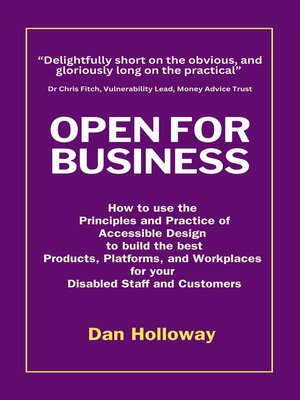Open for Business
ebook ∣ How to use the Principles and Practice of Accessible Design to build the best Products, Platforms, and Workplaces for your Disabled Staff and Customers
By Dan Holloway

Sign up to save your library
With an OverDrive account, you can save your favorite libraries for at-a-glance information about availability. Find out more about OverDrive accounts.
Find this title in Libby, the library reading app by OverDrive.



Search for a digital library with this title
Title found at these libraries:
| Library Name | Distance |
|---|---|
| Loading... |
The cost of inaccessible workplaces reaches far into people's personal lives, making them less full, less rich, more grey. The cost of inaccessibility in people's personal lives reaches far into their work life, lessening their ability to excel, reducing their opportunity to take on challenges that are personally and financially rewarding, making work more dull.
Those are the problems that the people who interact with organizations face. They are also a problem for those organizations.
Because staff are not just staff and customers are not just customers. They are people.
When you solve the problem of accessibility at the points where your organization deals with people, both when it looks in (to its staff) and when it looks out (to its customers), you will solve their problem. They will thrive. And that will solve your problem.
And the most important way to do this is by using accessible design.
The principles of accessible design can be expressed in two sentences.
Open for Business explains exactly what this means for any organization that wants to use accessible design to empower its staff and/or enable its customers.
Gain a vast toolkit of ready to deploy principles and practices from empathetic management to effective risk assessment; knowing how to solve the right problem to knowing when to involve lived experience; understanding the complexities of disabled life from the spiky profile to the cumulative effect of friction; producing effective communications to implementing tell it once systems, creating environments where people feel comfortable talking about the support they need to building systems and products that mean they don't have to share intimate details to access things others take for granted.
Accessible design expert Dan Holloway draws on 20 years' experience helping firms and regulators to deliver accessible products for consumers, and helping managers to to create inclusive workspaces for staff; on 30 years of research into the way design can be used to include or exclude; and a lifetime of experience as a disabled customer and employee.
Dan has worked with most of the leading high street banks;in higher education with the University of Oxford, Open University, Brookes University, and the Association of Research Managers and Administrators, with charities Mind, Money and Mental Health Policy Institute, Money Advice Trust, Christians Against Poverty, and Advice UK; with government bodies and regulators; and most recently helped Experian design and deliver the game-changing tell it once platform Support Hub.







